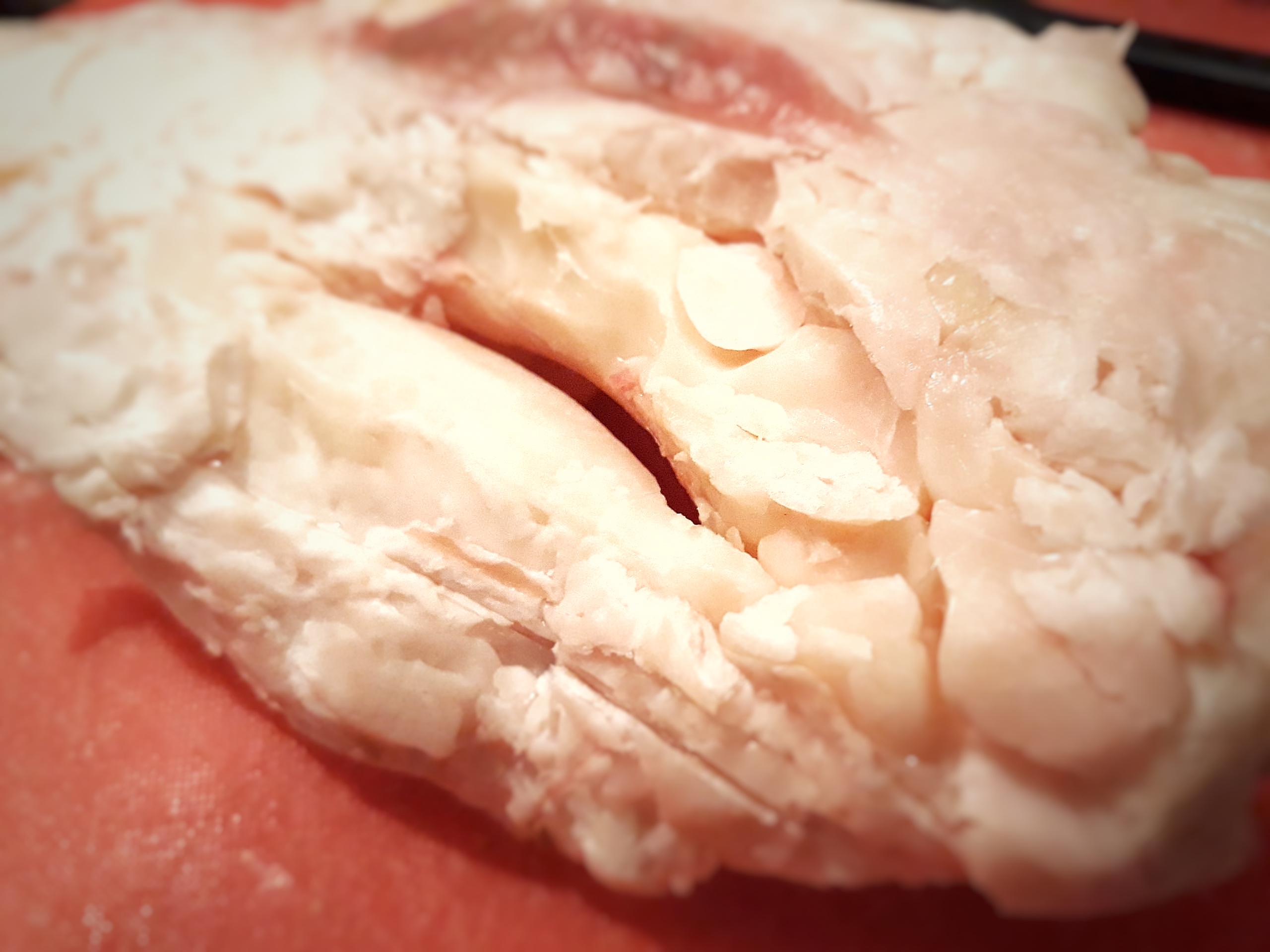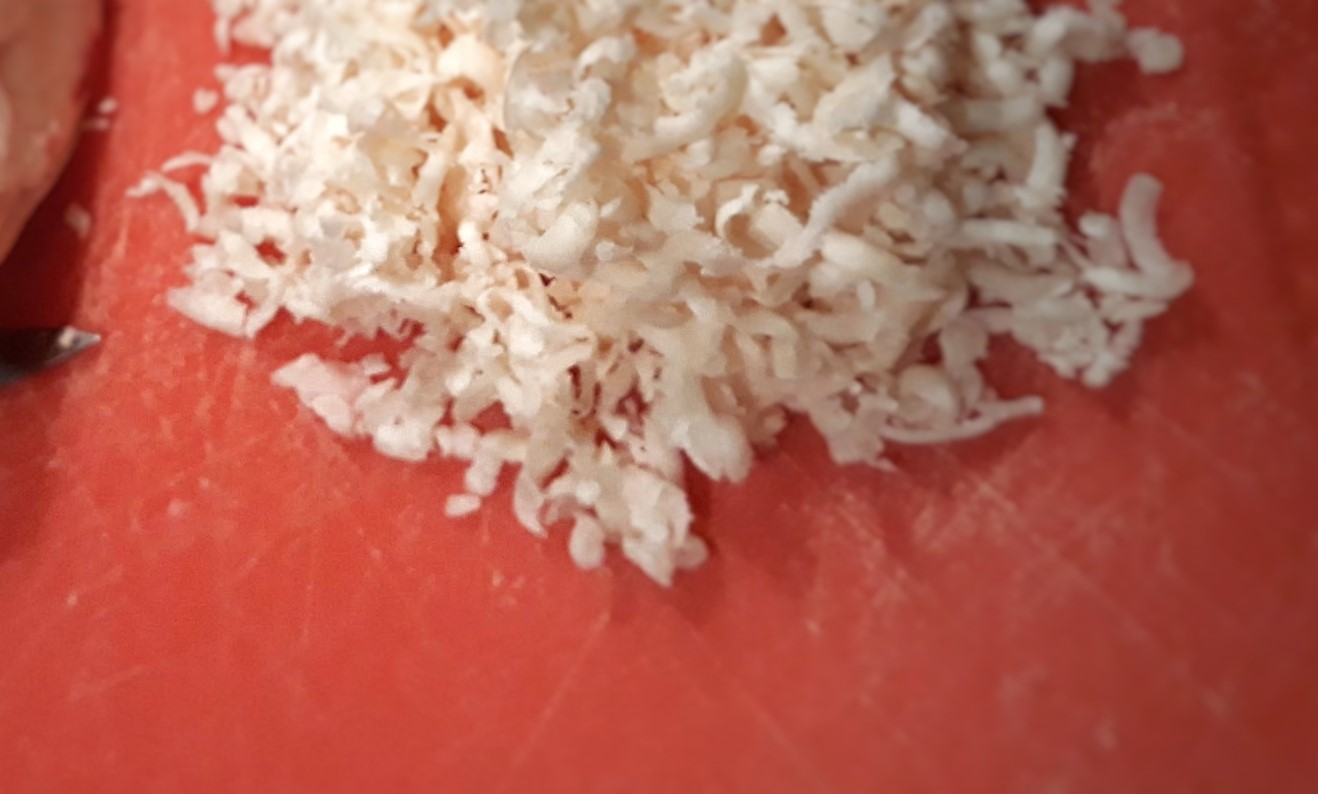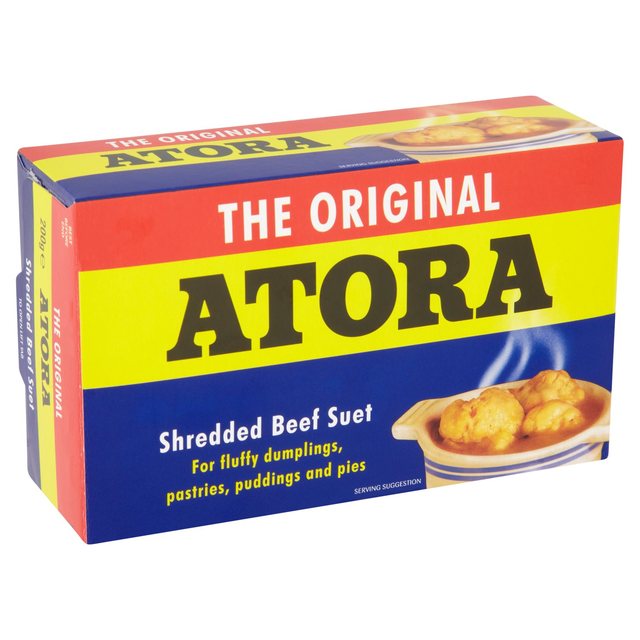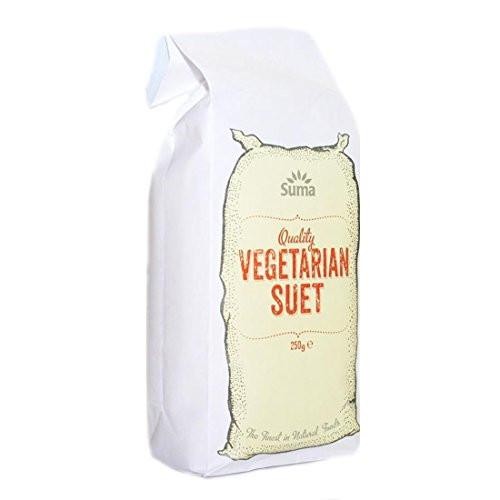Suet is the essential fat in many British puddings, both sweet and savoury, as well as stuffings and dumplings, mincemeat at Christmastime and – of – course suet pastry. It makes some of my most favourite British foods. It’s role is to enrich and lubricate mixtures, producing a good crust in steamed suet puddings.
Suet is the compacted, flaky and fairly homogenous fat that is found around animals’ kidneys, protecting them from damage. Here’s a very quick little guide to buying and using it in recipes.
 Flaky fresh beef suet
Flaky fresh beef suet
Don’t be put off by suet – I served up Jam Roly-Poly to a group of 18 American undergraduates recently, and they’d never heard of a suet pudding before. They all came back for seconds!
Several recipes already on the blog use suet:
- The forcemeat balls in Mock Turtle Soup
- The dumplings in Brown Windsor Soup
- Spotted Dick
- Jam Roly-Poly
- Jane Grigson’s Orange Mincemeat
- Mrs Beeton’s Mincemeat
Fresh Suet
Fresh suet can be bought from your local butcher at a very low price. Most commonly available is beef suet and it can be used in any recipe in the book. You can also buy lamb and pork suet – and sometime venison – which are all great when using the meat of the same animal in the filling (e.g. Lamb & Mint Suet Pudding). Pork suet is sometimes called flead or flare fat. Sweet suet puddings, however, require beef because it is flavourless, whilst lamb is distinctly lamby; not great in a Jam Roly-Poly.
Fresh suet can be minced at home or by your butcher or can be grated. I prefer to do the latter, as it’s quick and easy. You must avoid food processors however, as you end up with a paste. Grater or mincer, you will need to remove any membranes and blood vessels – much easier to do as you grate, hence why it’s my preferred method.
 Freshly-grated beef suet
Freshly-grated beef suet
I find it best to buy enough suet for several puddings, grate it and then freeze it. Fresh suet can be kept frozen for up to 3 months.

Preparatory Suet
Although not as good as fresh, packet suet bought from a supermarket is a perfectly good product and store cupboard standby. Atora is the iconic brand producing a shredded beef suet as well as a vegan alternative; these vegetable suets are made from palm oil and are therefore somewhat environmentally unfriendly. However, Suma produce one that is made from sustainably sourced palm oil, so keep a look out for that in shops.

Preparatory suet can be switched weight-for-weight in any recipe unless otherwise indicated.
And that’s my very quick beginners’ guide to suet, have a go at cooking with it, you won’t be disappointed.
If you like the blogs and podcast I produce, please consider treating me to a virtual coffee or pint, or even a £3 monthly subscription: follow this link for more information.

Thank you for this. I bought a pound of suet a few months ago to make your jam roly poly and still haven’t done so. But at least now I know more about how to use it! Thanks again.
LikeLike
Well hold back! I’m going to rewrite that post with a new recipe and pics this weekend… glad it’s a useful post!
LikeLike
I’ve just updated the roly poly post with improved method and photos! https://britishfoodhistory.com/2011/11/26/jam-roly-poly/
LikeLike
I always wonder with Atora, given that it’s 10% flour for manufacturing purposes, would adjusting the proportions accordingly when making the pastry make any difference. Can’t do any harm, I guess.
LikeLiked by 1 person
I dont think it makes any difference really and use it weight for weight and things always turn out fine
LikeLike
Another classic post!
LikeLiked by 1 person
Thanks man!
LikeLike
Neil, I’m not averse to using beef suet, but I have to go out of my way for it and so usually end up substituting butter because there aren’t many oils or oil products I use, other than extra virgin olive oil. So I appreciate your suggestion of buying enough for several puddings, grating it all at once and the freezing it. My freezer is my best friend! (But NOT for store-bought packaged frozen “convenience” foods, I should add.)
LikeLike
Yes always freeze a big batch. ‘Suet’ pastry with butter just isn’t right. Which is odd, as I pile the butter into almost everything else!
LikeLike
Pingback: Jam Roly-Poly | British Food: A History
Pingback: Apple Hat | British Food: A History
Pingback: Spotted Dick | British Food: A History
Pingback: To Make a Christmas (Plum) Pudding Part 1: Stir Up Sunday | British Food: A History
I’ve made a steak & kidney suet pudding with beef suet that I made from a piece of beef fat,
The pudding was so so tasty as I made the gravy from beef bones a bits the butcher gave me, can honestly say it was soooo flavoursome
The grating of the fat was messy tho, so I will freeze it next time, hopefully this will make it easier. I’ve just got a lump of lamb fat to shred now so thanks for the tips
LikeLiked by 1 person
Glad I was some help. Your food sounds delicious. Lamb suet makes excellent pastry, by the way!
LikeLike
Where I live, suet is not only VERY difficult to find, but, if found, is about as expensive as steak! When I can get it, I buy several pounds, weigh lumps (1-lb, 1/2 lb. 1/4 lb, snd freeze each lump in its own plastic bag, with weight written on it. The suet is easier to deal with (chop, grate, etc) while still frozen. Cheers!
Clarissa F. Dillon clarissafdillon@icloud.com
LikeLiked by 1 person
As expensive as steak!? Absolute craziness.
LikeLike
I loved ‘A. Cook’s Perspective’, by the way!
LikeLike
Pingback: Episode 56: 1964 – Year of the Dragon – Time Ram
It has been a struggle here in the US to find a butcher who knows what beef suet is. I’ve had many reputable butchers give me greasy fat and some have fought with me, insisting it was the fat from around the kidneys. This year I even had “suet” I had ordered from a farm, where they should know, send me a small pile of fat pieces, a few of which might have been suet.
Several years ago I finally found a butcher in Brooklyn who knew what I wanted and why I wanted it. The puddings were always perfect. But this year, they changed their ordering process and I got handed a pound of slippery ground fat. After some searching I found a butcher whom I persuaded to hack some suet off the cow for me. It was an unusual order for them, clearly.
I was happy to have a hunk, but for the first time my pudding was a disappointment. Steamed nicely, plated perfectly, even tasted good. However, that beautiful dark “pud” is spotted with small chunks and flecks of suet that did not melt. Makes it very unappealing visually. Not sure what I did wrong.
I grated the suet, but also minced some of it. Not sure what the mince would be a problem as the butcher I used for all those years apparently ground it with possibly a 1/4” or 3/8” plate. That all melted into the pudding, no problem.
Any ideas on what the issue might have been? I read somewhere that if you don’t grate or ground and only mince you’re not breaking down the connective tissue so it holds its shape. Nearing the end of Christmastide, but I’m already thinking about next year and how I can guarantee a return to the wonderful suet experiences of the past.
LikeLike
Yes, getting old of suet is tricky in the USA. I just bought the packet stuff online when I lived there.
The problem you had with your suet is probably because you minced it. When grating or finely chopping, you also find the membranes which you can extract as you go. Sorry for short answer! Away grom computer…
LikeLike
Pingback: Steamed Marmalade Pudding - Performance High
Pingback: A Recipe for Early Modern Black Puddings | British Food: A History
Pingback: White Pudding | British Food: A History